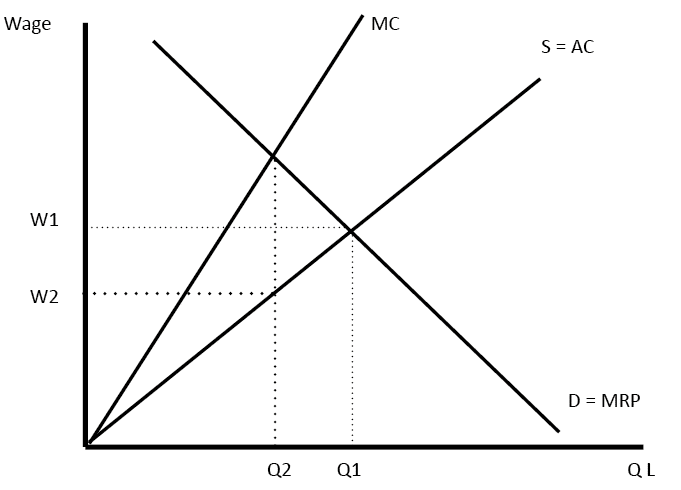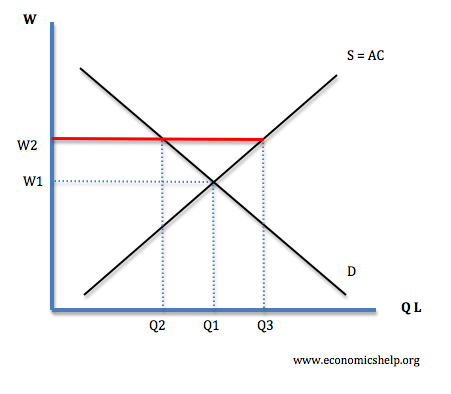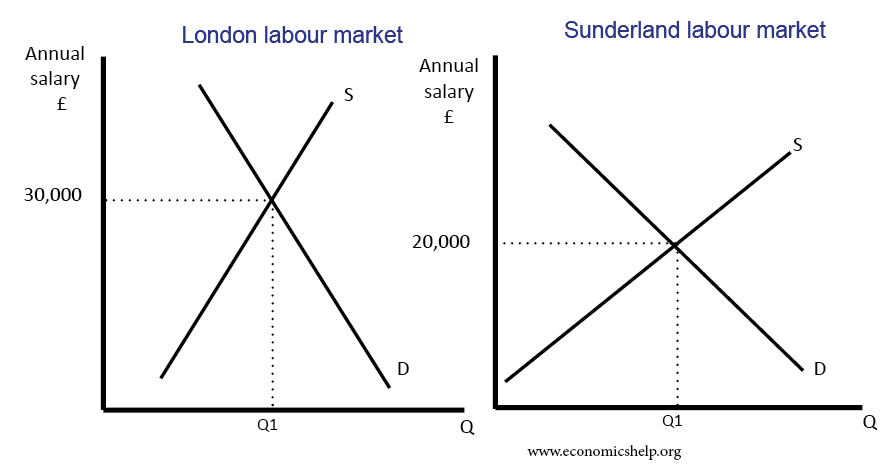In the real world, labour markets are rarely perfectly competitive. This is because workers or firms usually have the power to set and influence wages and therefore wages may be set to levels different than anticipated by Marginal Revenue Product (MRP) theory.
Imperfections in the labour market cause wages to differ from a competitive equilibrium.
Different Imperfections in the Labour Market
- Monopsony
- Trade unions
- Discrimination
- Difficult to measure productivity
- Firms, not profit maximisers
- Geographical immobiliities
- Occupational immobilities
- Poor information
1. Monopsony
Monopsony occurs when there is just one buyer of labour in a market. This gives the firm market power in employing workers. The monopsony can set (lower) wages and limit the quantity of workers.
- The marginal cost of employing one more worker will be higher than the average cost because to employ one extra worker the firm has to increase the wages of all workers.
- To maximise the level of profit the firm employs Q2 of workers where MC = MRP
- Therefore the firm only has to pay a wage of W2. This is less than the competitive wage.
Even if there is more than one employer, firms may still have the ability to set wages and have a degree of monopsony power. For workers, there are significant costs and difficulties in moving between employers. This means that if wages are low, it is costly to give up the job and work for a firm with slightly higher wages.
2. Trades Unions
Under certain conditions, Trades unions can bargain for wages above the competitive equilibrium
This can be achieved by restricting the supply of labour (e.g. closed shops) or threatening to go on strike.
Trades Unions can cause higher wages, however, in competitive markets, this can have the effect of causing unemployment of Q1 – Q2
However, Trades Unions can be beneficial if:
- They operate in an industry with a Monopsonistic employer
- They help to increased productivity by bringing in new working practices
- Demand for labour is inelastic
- Efficiency wage theories – when higher wages lead to higher productivity.
3. Discrimination
Firms may not be rational but pay some workers different wages on the grounds of age, race, or gender. See: discrimination in labour markets.
4. Difficult to measure productivity
The theory of MRP assumes firms can measure the MPP of a worker however in practice this is difficult because in many jobs, especially in the service sector productivity cannot be measured precisely
e.g. how do we measure the productivity of nurses and teachers?
Therefore wages may be set due to different reasons other than MRP
5. Firms may be non-profit maximisers
If demand for a product falls, MRP theory suggests wages are likely to fall. However, firms may be reluctant to cut wages or make people redundant therefore they may keep paying high wages despite this.
6. Wages will vary due to geographical differences
In the north (e.g. Sunderland), wages tend to be lower because there are less demand, higher unemployment and more elastic supply curve of labour. In the South, wages tend to be higher for the opposite reason – firms are more profitable and are willing to pay higher wages.
In theory, workers from the north could move to the south to take advantage of better employment opportunities. However, there are likely to be geographical immobilities – e.g. it is difficult for workers to move. Geographical immobilities can include
- Workers have attachments to their local communities – friends, children at local schools.
- Difficult to find housing in the south.
- Poor information about jobs elsewhere
7. Occupational immobilities
Even at periods of full employment (strong economic growth) workers can be unemployed due to occupational immobilities. This involves having inadequate skills for the labour market. In a fast-changing economy, some workers can be left behind when old industries close down and their former skills are not transferable to new jobs. For example, manual workers from manufacturing may struggle in a high tech service sector based economy. This can lead to structural unemployment.
8. Poor information
Workers or firms may suffer from poor information. E.g. workers may be unaware of better-paid jobs elsewhere. Poor information is one factor that enables firms to have monopsony power.
Related



